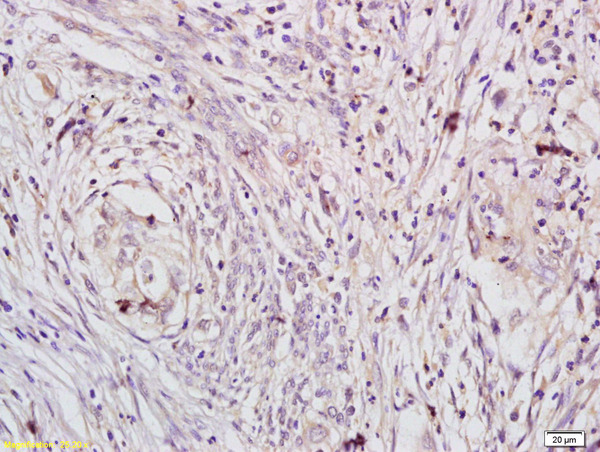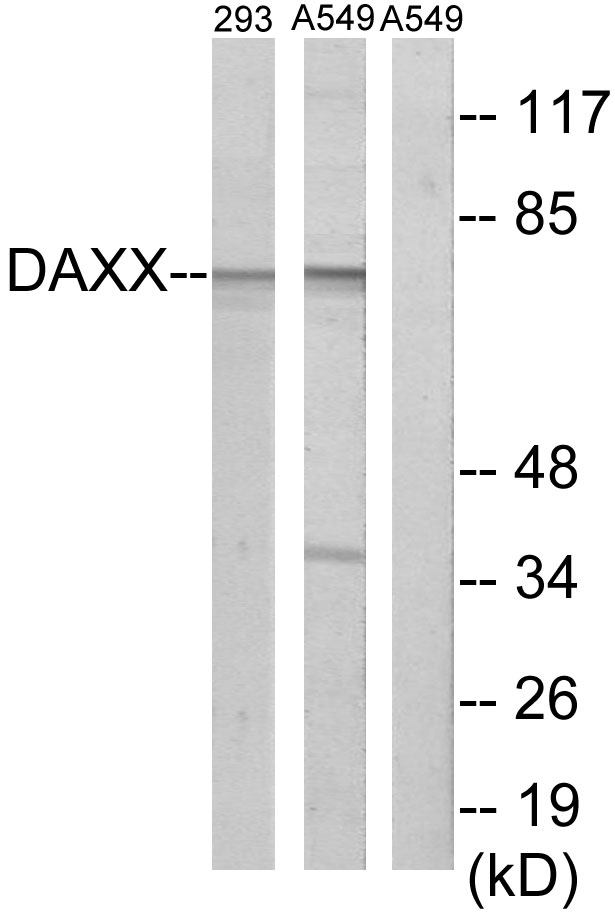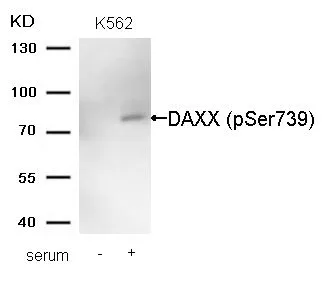![ICC/IF analysis of HeLa cells transfected with Myc-Daxx only (Panel A) or co-transfected with MycDaxx / ASK1HA (Panel B) using GTX29091 Daxx antibody [DAXX-01]. Co-transfected with pCDNA3-MycDaxx and pCDNA3-ASK1HA, which led to translocation of Daxx from nucleus to cytoplasm. Green : Primary antibody Blue : DAPI ICC/IF analysis of HeLa cells transfected with Myc-Daxx only (Panel A) or co-transfected with MycDaxx / ASK1HA (Panel B) using GTX29091 Daxx antibody [DAXX-01]. Co-transfected with pCDNA3-MycDaxx and pCDNA3-ASK1HA, which led to translocation of Daxx from nucleus to cytoplasm. Green : Primary antibody Blue : DAPI](https://www.genetex.com/upload/website/prouct_img/normal/GTX29091/GTX29091_20191028_ICC-IF_1_w_23060722_949.webp)
ICC/IF analysis of HeLa cells transfected with Myc-Daxx only (Panel A) or co-transfected with MycDaxx / ASK1HA (Panel B) using GTX29091 Daxx antibody [DAXX-01]. Co-transfected with pCDNA3-MycDaxx and pCDNA3-ASK1HA, which led to translocation of Daxx from nucleus to cytoplasm. Green : Primary antibody Blue : DAPI
Daxx antibody [DAXX-01]
GTX29091
ApplicationsImmunoFluorescence, Western Blot, ImmunoCytoChemistry
Product group Antibodies
TargetDAXX
Overview
- SupplierGeneTex
- Product NameDaxx antibody [DAXX-01]
- Delivery Days Customer9
- ApplicationsImmunoFluorescence, Western Blot, ImmunoCytoChemistry
- CertificationResearch Use Only
- ClonalityMonoclonal
- Clone IDDAXX-01
- Concentration1 mg/ml
- ConjugateUnconjugated
- Gene ID1616
- Target nameDAXX
- Target descriptiondeath domain associated protein
- Target synonymsBING2, DAP6, EAP1, SMIM40, death domain-associated protein 6, CENP-C binding protein, ETS1-associated protein 1, Fas-binding protein, death-associated protein 6, fas death domain-associated protein
- HostMouse
- IsotypeIgG1
- Protein IDQ9UER7
- Protein NameDeath domain-associated protein 6
- Scientific DescriptionThis gene encodes a multifunctional protein that resides in multiple locations in the nucleus and in the cytoplasm. It interacts with a wide variety of proteins, such as apoptosis antigen Fas, centromere protein C, and transcription factor erythroblastosis virus E26 oncogene homolog 1. In the nucleus, the encoded protein functions as a potent transcription repressor that binds to sumoylated transcription factors. Its repression can be relieved by the sequestration of this protein into promyelocytic leukemia nuclear bodies or nucleoli. This protein also associates with centromeres in G2 phase. In the cytoplasm, the encoded protein may function to regulate apoptosis. The subcellular localization and function of this protein are modulated by post-translational modifications, including sumoylation, phosphorylation and polyubiquitination. Alternative splicing results in multiple transcript variants. [provided by RefSeq, Nov 2008]
- Storage Instruction2°C to 8°C
- UNSPSC12352203





![WB analysis of U937 cell lysate using GTX80185 Daxx antibody [DAXX-03].](https://www.genetex.com/upload/website/prouct_img/normal/GTX80185/GTX80185_20191028_WB_1_w_23061322_742.webp)
![FACS analysis of HeLa cells using GTX83312 Daxx antibody [7A11]. Green : Daxx Purple : negative control](https://www.genetex.com/upload/website/prouct_img/normal/GTX83312/GTX83312_20170912_FACS_w_23061322_315.webp)
